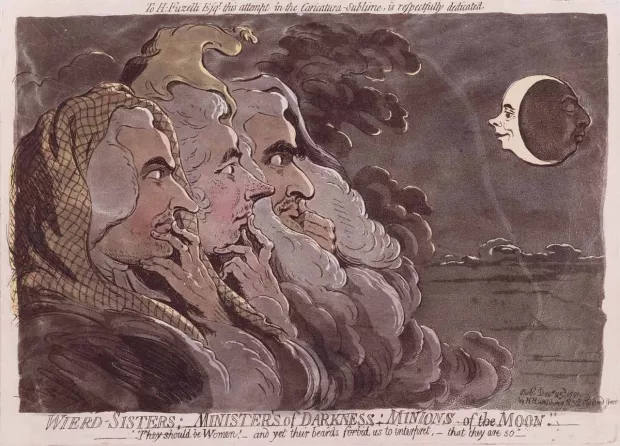Creation Date
1791
Height
22 cm
Width
33 cm
Medium
Genre
Description
This satirical commentary on the Regency Crisis and the madness of George III portrays the leading government officials of the time—Pitt the Younger, Edward Thurlow, and Henry Dundas—as the the three witches from Shakespeare's Macbeth, parodying Fuseli's own depiction of the "weird sisters."
Three men in white wigs with shawls over their heads gaze contemplatively at the moon from a bank of dark clouds. The moon is made up of two faces: the light side is smiling, while the dark side is sleeping. More dark clouds make up the background. Over the top of the image, in script: “To H. Fuzelli Esq. this attempt in the Caricatura-Sublime, is respectfully dedicated.” On the bottom, in block letters: “WIERD-SISTERS; MINISTERS of DARKNESS; MINIONS of the MOON.” Underneath this, also script: “They should be Women! and yet their beards forbid us to interpret that they are so.” In the lower right-hand corner of the image, script: “Pub. Dec 23, 1791 by H. Humphrey, No. 18 Old Bond Street.” This image was first displayed in the window of Mrs. Humphrey’s print shop for the entertainment and education of passers-by. The Tate Museum in London displayed this image twice: in 2001 as part of “James Gillray: The Art of Caricature” and in 2006 as part of “Gothic Nightmares: Fuseli, Blake, and the Romantic Imagination” ("James Gillray").
Caricature and propaganda were an important part of the political climate of the time, and opportunities for satire were abundant in a nation whose ruler was going mad. Caricatures attempted to illustrate for the public the unhealthy state of the English nobility—perhaps trying to garner support for the French Revolution and the overthrow, or at least the reorganization, of the ruling class (Donald 142). The effects of this satirical imagery, however, were difficult to control, and caricatures often sparked visceral, passionate responses that were unregulated by text. Both the grotesque images of Fuseli and the satires of Gillray are examples of caricatures that were able to incite such reactions in viewers. Weird Sisters in particular shows the influence that the Romantic fascination with the supernatural had on the genre of caricature, and demonstrates how such influence, by combining the strong emotions invoked by the unknown with those invoked by political outrage, could be especially effective.
Associated Persons
Associated Works
Copyright
Copyright, 2009, Yale Center for British Art, Paul Mellon Collection
Publisher
Hannah Humphrey
Collection
Accession Number
B1981.25.853
Additional Information
Bibliography
Donald, Diana. Age of Caricature: Satirical Prints in the Reign of George III. New Haven: Yale UP, 1996. Print. The Paul Mellon Centre for Studies in British Art.
Fuseli, Henry. The Life and Writings of Henry Fuseli. Ed. John Knowles. Vol. 1. London, 1831. Internet Archive. Web. 21 Mar. 2009.
George, Mary Dorothy. Catalogue of Political and Personal Satires. 11 vols. London: British Museum, 1948.
"James Gillray: The Art of Caricature." Tate Britain. Tate, 2001. Web. 01 Apr. 2009.
Matthew, Henry Colin Gray, and Brian Howard Harrison. Oxford Dictionary of National Biography. Illustrated ed. Vol. 22. Oxford: Oxford UP, 2004. Print.
Thomas, Peter G. D. George III: King and Politicians 1760-1770. Illustrated ed. New York: Manchester UP, 2003. Print.
Turner, Michael J. Pitt the Younger: a Life. London: Hambledon and London, 2003. Print.
Wright, Thomas, Robert Harding Evans, and James Gillray. Historical and Descriptive Account of the Caricatures of James Gillray. London, 1851. Print.

